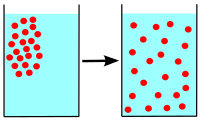
Photo from wikipedia
Abstract. Vertical sediment temperature profiles are frequently used to estimate vertical fluid fluxes. In these applications using heat as a tracer of groundwater flow, the thermal conductivity of saturated sediments… Click to show full abstract
Abstract. Vertical sediment temperature profiles are frequently used to estimate vertical fluid fluxes. In these applications using heat as a tracer of groundwater flow, the thermal conductivity of saturated sediments (ke) is often given as a standard literature value and assumed to have a homogeneous distribution in the vertical space. In this study vertical sediment temperature profiles were collected in both a high-flux stream and a low-flux lagoon environment in sand- and peat-covered areas. ke was measured at the location of each temperature profile at several depths below the sediment–water interface up to 0.5 m with a measurement spacing of 0.1 m. In general ke values measured in this study ranged between 0.55 and 2.96 W m−1 ∘C−1 with an increase with depth from the sediment–water interface. The effect of using a vertically homogeneous or heterogeneous distribution of measured ke values on vertical flux estimates was studied with a steady-state HydroGeoSphere model. In the high-flux stream environment estimated fluxes varied between 0.03 and 0.71 m d−1 and in the low-flux lagoon between 0.02 and 0.23 m d−1. We found that using a vertically heterogeneous distribution of sediment thermal conductivity did not considerably change the fit between observed and simulated temperature data compared to a homogeneous distribution of ke. However, depending on the choice of sediment thermal conductivities, flux estimates decreased by up to 64 % or increased by up to 75 % compared to using a standard ke sediment thermal conductivity for sand, frequently assumed by previous local studies. Hence, our study emphasizes the importance of using spatially distributed thermal properties in heat flux applications in order to obtain more precise flux estimates.
Journal Title: Hydrology and Earth System Sciences
Year Published: 2019
Link to full text (if available)
Share on Social Media: Sign Up to like & get
recommendations!